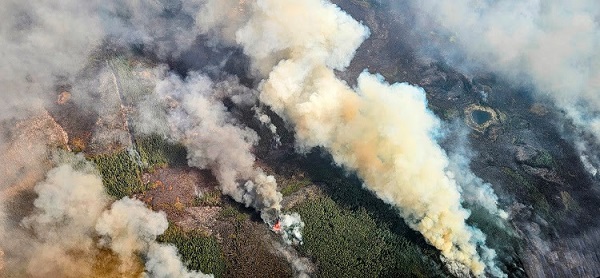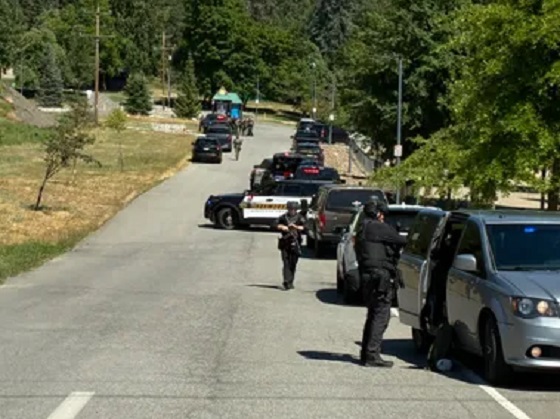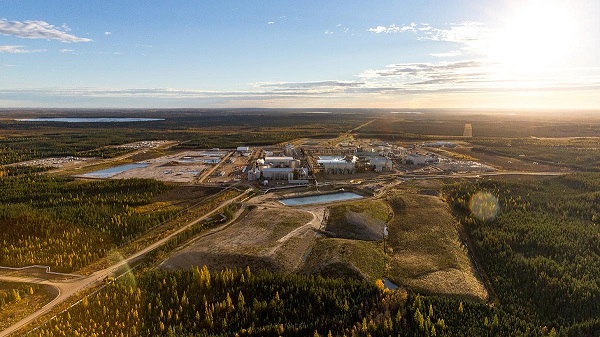Alberta
Preparation, swift response define wildfire season

Aerial view of wildfires near Fox Lake and Garden River in July.
Alberta concludes its 2024 wildfire season with renewed resilience, as vigilance and swift action helped keep communities safe and ready for the future.
Through effective investments, including a historic $155-million wildfire base budget, Alberta’s government ensured the province was prepared to respond throughout the 2024 wildfire season. In anticipation of the wildfire season, Alberta’s government recruited 100 additional wildland firefighters and an additional 40 contract wildland firefighters – in addition to securing more airtankers, heavy equipment, and helicopters equipped with night vision technology. As a result of this preparation, front-line crews were able to respond quickly and fight fires around the clock, containing 85 per cent of wildfires within 24 hours of detection.
“While the 2024 wildfire season was challenging, our coordinated efforts and the resilience of Albertans have been crucial in mitigating the impact. We will continue to adapt and strengthen our wildfire management strategies to protect our communities and natural resources.”
“This wildfire season has tested our resolve, especially in areas like Fox Lake and Jasper. The coordinated efforts of our firefighters and support teams were instrumental in protecting our communities. We will build on this experience to continue to improve response strategies and initiate new strategies to ensure the safety of all Albertans.”
The 2024 wildfire season began earlier than usual, with 64 carryover wildfires stemming from a mild winter and extremely dry conditions. In response to this elevated danger, Alberta’s government activated an early start to the wildfire season on February 20, 2024, implementing a fire ban and fire permit system to prevent additional human-caused wildfires.
Despite significant challenges, including large wildfires near Jasper that led to evacuations and the tragic loss of an Alberta wildland firefighter, as well as the loss of homes and businesses in the community, Alberta Wildfire demonstrated remarkable coordination, offering immediate aid and resources to Parks Canada, including support personnel, firefighters, aircraft and equipment.
While supporting the Jasper response led by Parks Canada, Alberta Wildfire crews continued to tackle substantial wildfires throughout the province, deploying personnel, aircraft and equipment to combat wildfires and assist impacted communities. Throughout the season, residents of Garden River, John D’Or Prairie, Fox Lake in the Little Red River Cree Nation, and the Chipewyan Cree Nation were also evacuated. Additionally, an area near Peace River and four neighborhoods in Fort McMurray faced short-term evacuations due to wildfires.
“In the wake of the heartbreaking loss from the Jasper wildfire, we are reminded of the strength found in collaboration – with each other and among all orders of government. We are reminded also of the compelling need to invest together in training, preparation, mitigation and adaptation, ensuring that we not only respond effectively, but that we also build a more resilient future.”
“The 2024 wildfire season underscored the importance of early planning and preparation. Investments in people, resources and new technology proved invaluable in our response efforts.”
During the 2024 wildfire season, Alberta Wildfire responded to more than 1,210 wildfires in the Forest Protection Area, exceeding last year’s record-breaking total. While the number of fires in 2024 exceeded the total number of fires in 2023, wildfires this season burned less than a third of the area compared with 2023, underscoring the effectiveness of Alberta’s preparation and investments.
Although Oct. 31 marks the end of Alberta’s wildfire season, Alberta Wildfire remains vigilant and ready to respond to any potential wildfires across the province.
Quick Facts
- Alberta Wildfire responded to more than 1,210 wildfires this year with more than 705,000 hectares burned.
- In 2023, there were 1,080 wildfires and more than 2.2 million hectares burned.
- Alberta Wildfire had almost 1,900 firefighters, contractors and support staff working on Alberta’s provincial response.
- Alberta Wildfire also received assistance from other agencies with more than 1,300 firefighters and support staff arriving from around the world to assist.
- While most wildfires were caused by people, we had 410 lightning-caused wildfires in July, the highest number in 20-years.
Related information
Alberta
Alberta judge sides with LGBT activists, allows ‘gender transitions’ for kids to continue

From LifeSiteNews
‘I think the court was in error,’ Alberta Premier Danielle Smith has said. ‘There will be irreparable harm to children who get sterilized.’
LGBT activists have won an injunction that prevents the Alberta government from restricting “gender transitions” for children.
On June 27, Alberta King’s Court Justice Allison Kuntz granted a temporary injunction against legislation that prohibited minors under the age of 16 from undergoing irreversible sex-change surgeries or taking puberty blockers.
“The evidence shows that singling out health care for gender diverse youth and making it subject to government control will cause irreparable harm to gender diverse youth by reinforcing the discrimination and prejudice that they are already subjected to,” Kuntz claimed in her judgment.
Kuntz further said that the legislation poses serious Charter issues which need to be worked through in court before the legislation could be enforced. Court dates for the arguments have yet to be set.
READ: Support for traditional family values surges in Alberta
Alberta’s new legislation, which was passed in December, amends the Health Act to “prohibit regulated health professionals from performing sex reassignment surgeries on minors.”
The legislation would also ban the “use of puberty blockers and hormone therapies for the treatment of gender dysphoria or gender incongruence” to kids 15 years of age and under “except for those who have already commenced treatment and would allow for minors aged 16 and 17 to choose to commence puberty blockers and hormone therapies for gender reassignment and affirmation purposes with parental, physician and psychologist approval.”
Just days after the legislation was passed, an LGBT activist group called Egale Canada, along with many other LGBT organizations, filed an injunction to block the bill.
In her ruling, Kuntz argued that Alberta’s legislation “will signal that there is something wrong with or suspect about having a gender identity that is different than the sex you were assigned at birth.”
She further claimed that preventing minors from making life-altering decisions could inflict emotional damage.
However, the province of Alberta argued that these damages are speculative and the process of gender-transitioning children is not supported by scientific evidence.
“I think the court was in error,” Alberta Premier Danielle Smith said on her Saturday radio show. “That’s part of the reason why we’re taking it to court. The court had said there will be irreparable harm if the law goes ahead. I feel the reverse. I feel there will be irreparable harm to children who get sterilized at the age of 10 years old – and so we want those kids to have their day in court.”
READ: Canadian doctors claim ‘Charter right’ to mutilate gender-confused children in Alberta
Overwhelming evidence shows that persons who undergo so-called “gender transitioning” procedures are more likely to commit suicide than those who are not given such irreversible surgeries. In addition to catering to a false reality that one’s sex can be changed, trans surgeries and drugs have been linked to permanent physical and psychological damage, including cardiovascular diseases, loss of bone density, cancer, strokes and blood clots, and infertility.
Meanwhile, a recent study on the side effects of “sex change” surgeries discovered that 81 percent of those who have undergone them in the past five years reported experiencing pain simply from normal movements in the weeks and months that followed, among many other negative side effects.
Alberta
Alberta Independence Seekers Take First Step: Citizen Initiative Application Approved, Notice of Initiative Petition Issued

Alberta’s Chief Electoral Officer, Gordon McClure, has issued a Notice of Initiative Petition.
This confirms a Citizen Initiative application has been received and the Chief Electoral Officer has determined the requirements of section 2(3) of the Citizen Initiative Act have been met.
Approved Initiative Petition Information
The approved citizen initiative application is for a policy proposal with the following proposed question:
Do you agree that Alberta should remain in Canada?
The Notice of Initiative Petition, application, and statement provided by the proponent are available on Elections Alberta’s website on the Current Initiatives Petition page.
As the application was received and approved prior to coming into force of Bill 54: Election Statutes Amendment Act, the Citizen Initiative process will follow requirements set out in the Citizen Initiative Act as of June 30, 2025.
Next Steps
- The proponent must appoint a chief financial officer within 30 days (by July 30, 2025).
- Once the 30-day publication period is complete and a chief financial officer has been appointed, Elections Alberta will:
- issue the citizen initiative petition,
- publish a notice on the Current Initiatives Petition page of our website indicating the petition has been issued, specifying the signing period dates, and the number of signatures required for a successful petition, and
- issue the citizen initiative petition signature sheets and witness affidavits. Signatures collected on other forms will not be accepted.
More information on the process, the status of the citizen initiative petition, financing rules, third party advertising rules, and frequently asked questions may be found on the Elections Alberta website.
Elections Alberta is an independent, non-partisan office of the Legislative Assembly of Alberta responsible for administering provincial elections, by-elections, and referendums.
-

 Alberta1 day ago
Alberta1 day agoAlberta judge sides with LGBT activists, allows ‘gender transitions’ for kids to continue
-

 Crime17 hours ago
Crime17 hours agoNational Health Care Fraud Takedown Results in 324 Defendants Charged in Connection with Over $14.6 Billion in Alleged Fraud
-

 Business1 day ago
Business1 day agoCanada Caves: Carney ditches digital services tax after criticism from Trump
-

 Alberta1 day ago
Alberta1 day agoAlberta Independence Seekers Take First Step: Citizen Initiative Application Approved, Notice of Initiative Petition Issued
-

 Health17 hours ago
Health17 hours agoRFK Jr. Unloads Disturbing Vaccine Secrets on Tucker—And Surprises Everyone on Trump
-

 Business6 hours ago
Business6 hours agoElon Musk slams Trump’s ‘Big Beautiful Bill,’ calls for new political party
-

 Crime1 day ago
Crime1 day agoSuspected ambush leaves two firefighters dead in Idaho
-

 Business1 day ago
Business1 day agoMassive government child-care plan wreaking havoc across Ontario






